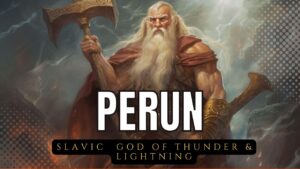In the pantheon of Slavic gods, few are as revered and feared as Perun, the god of thunder and lightning. Known for his fierce power and wrathful nature, Perun is a complex and multifaceted deity whose mythology spans the ages. Perun is often depicted as a tall, muscular man with a flowing beard and piercing eyes. He is usually dressed in armor and wields a mighty axe, which he uses to cleave the skies and strike down his enemies. As the god of thunder, Perun controls the weather and is responsible for the thunderstorms that sweep across the land.
But Perun is more than just a force of nature. He is also a god of justice and righteousness, punishing those who break the laws of society or betray their oaths. In this role, he is often associated with the king or ruler, as he represents the power and authority of the state. Perun’s mythology is filled with tales of his exploits and triumphs. In one story, he battles the demon Veles, who has stolen his cattle and hidden them in the underworld. Perun pursues Veles into the depths of the earth and engages him in a fierce battle, eventually triumphing and retrieving his cattle.
In another story, Perun is called upon to settle a dispute between two brothers, both of whom claim the throne of their kingdom. Perun tests the brothers’ worthiness by having them engage in a series of tasks, such as plowing fields and building houses. In the end, the younger brother proves himself the better ruler, and Perun rewards him with the throne. Despite his fearsome reputation, Perun is also a god of fertility and abundance. He is associated with the oak tree, which was believed to be the source of all life, and was often worshipped in sacred groves or forests. As a fertility god, Perun was often invoked by farmers and herders to bring rain and ensure a bountiful harvest.
Perun’s influence can still be seen today in Slavic culture and folklore. His name is often invoked in prayers and blessings, and his symbol, the thunderbolt, is a common motif in Slavic art and architecture. Even today, many Slavic countries celebrate Perun’s feast day on July 20th, with processions, feasting, and fireworks. For the Slavic people, Perun was more than just a god; he was a symbol of their strength and resilience in the face of adversity. His mythology is a testament to the power of nature, the importance of justice, and the value of hard work and determination. So the next time you see lightning flash across the sky, remember the mighty Perun, and the legacy he left behind.
Perun did, in fact, wield a thunder hatchet in his left hand and a flaming bow in his right, and his crown was fashioned from lightning rods. Thunder rolled over the land every time Perun flung his hatchet. Lightning flashed across the sky every time he let go with his bow. It was as though the heavens parted and our forefathers found themselves in a parallel universe.
Slavic Gods
 Discover the rich and fascinating world of Slavic mythology with this immersive guide to the gods and goddesses of ancient Eastern Europe. From Perun, the god of thunder, to Morana, the goddess of death, these deities are brought to life in vivid detail, with tales of love, war, and magic that will captivate readers of all ages. Explore the hidden depths of Slavic folklore and learn about the customs and traditions that have shaped this unique culture over thousands of years. With stunning illustrations and expert analysis, this book is an essential resource for anyone interested in mythology, history, or the beauty of Eastern Europe. So whether you’re a seasoned mythologist or a curious newcomer, join us on a journey through the enchanted forests and misty mountains of Slavic legend, and discover a world of wonder and mystery that will leave you breathless.
Discover the rich and fascinating world of Slavic mythology with this immersive guide to the gods and goddesses of ancient Eastern Europe. From Perun, the god of thunder, to Morana, the goddess of death, these deities are brought to life in vivid detail, with tales of love, war, and magic that will captivate readers of all ages. Explore the hidden depths of Slavic folklore and learn about the customs and traditions that have shaped this unique culture over thousands of years. With stunning illustrations and expert analysis, this book is an essential resource for anyone interested in mythology, history, or the beauty of Eastern Europe. So whether you’re a seasoned mythologist or a curious newcomer, join us on a journey through the enchanted forests and misty mountains of Slavic legend, and discover a world of wonder and mystery that will leave you breathless.
 







